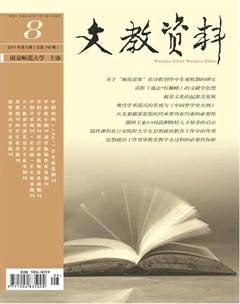浅谈英语中的强调手段
蔡瑞辰
摘 要: 在英语交际过程中,强调是人们交流思想的一种重要手段。恰当使用强调方式可使语言具有强烈的感情色彩,有助于交际的顺利进行。英语中的强调手段运用非常丰富,本文系统地从语音、词汇、语法、修辞四个方面探讨英語中的强调手段。
关键词: 强调 语音手段 词汇手段 语法手段 修辞手段
无论说话或行文,人们为了表达不同的思想感情,常常需要给句子的某一部分以突出的地位,加以强调,这样就产生了强调手法。英语中主要运用语音、语法、词汇和修辞四种手段完成强调任务,下面分别举例论之。
一、用语音手段进行强调
根据说话人的需要通过调心(nucleus)位置的移动,达到对同一语调组(tone unit)中不同词语进行强调的目的。
1.强调主语
——Which is yours and which is mine?
——Thats mine and this is yours.
2.强调表语
——Whose is that and whose is this?
——Thats mine and this is yours.
3.强调谓语
——I cant sing this song in English.
——Lucy can sing this song in English well.
4.强调宾语
——Tom can sing that song in English well.
——Lucy can sing this song in English well.
5.强调状语
——Tom can sing this song in Chinese well.
——Lucy can sing this song in English well.
6.强调定语
“Its your order,” said William Tell, “not mine. ”
Well show you whose order it is...
7.强调补语
——What did she want to make her mother?
——She wanted to make her mother happy.
二、用词汇手段进行强调
根据说话人的需要,采用一些具有强调意味的词、词组,诸如形容词、副词(词组)、疑问词、否定词、反身代词等进行强调。
1.用形容词强调
(1)Dont you believe me? No, and I wont until I see you in the jar with my own eyes.
(2)I had to think of a way of preventing him from following me around all morning.
2.用副词强调
(1)This beast is exactly like a wall.
(2)So Gessler decided to get even together.
3.用词组强调
(1)The pacific is by far the largest ocean.
(2) The program is performed by the women of the area.
(3)What on earth are you doing here?
4.用疑问词强调
What did you come here to do?
5.用不定代词强调
(1)This elephant is like a snake,as anybody can see.
(2)Even the blindest person must see that this elephant isnt like any of the things you name.
6.用反身代词强调
(1)May I help you carry the box upstairs?
(2)No, I can do it by myself.
7.用否定词/词组强调
(1)I dont know anything about it at all.
(2)I never enjoy meeting Bert Hall.
8.用介词强调
(1)Last night I didnt have any supper except a piece of bread.
(2)They invited nobody in my office but me.
9.用连词强调
It is not important to you but to me.
三、运用语法手段进行强调
说话人用改变词序、倒装句子、运用被动语态或强调句等手段突出语意的主要信息。
1.改变词序
(1)a. Antonio gave Bassanio the money.
b. Antonio agreed and gave the money to Bessanio.
(2)a. Della had only $ 1.87 with which to buy Jim a present.
b. Della had only $ 1.87 to buy a present for Jim.
以上四句略加比較,就可知句(1)a 、(2)a是一般陈述,用了正常语序;而句(1)b、 (2)b句则将间接宾语借助介词后置,强调了间接宾语。
2.倒装句子
(1)a. I have never seen him before.
b. Never have I seen him before.
比较:(1)a句为正句,一般表述;(1)b句则是倒装句,由于never一词置于句首,受到了强调,致使助动词have(部分谓语动词)放在了主语“I”之前。很明显,倒装句较之正常语序语气重。
(2)Only then did I understand that he, too, was an Englishman.
显然,该句强调的是状语then, only是有强调意味的副词,放在then前,对then再强调。
(3)This they kept for themselves.
该句中,this 是kept 的宾语,宾语前置,受到强调。
(4)There, on the shore, were nine savages.
There 与on the shore是同位语,用作表语,前置句首,受到强调。
3.运用被动语态
English was required for study in many schools.
主语English受到强调。
4.利用强调句型、助动词或词组
(1)It is not only blind men who make such stupid mistakes.
(2)It is not until a blind person is treated like a normal human being that he knows his hidden strength.
It is ...that (who)...是典型的强调句型之一。这种强调句型的特点是将It is ...that (who)...去掉,整个句子依然成立。它一般可用来强调主语、宾语、时间状语、地点状语等。上边两个例句,句(1)强调的是主语,句(2)强调的是时间状语。
(3)His enemies could not let Lincoln continue his work.
该句的谓语部分中,could not 本可以缩写,现在不缩写,则具有了强调意味。下列各句皆属此类:
a. The doctor did not dare to tell the king the reason.
b. It was no use pretending that I had not seen him...
c. I am a citizen of Switzerland, not Austria.
d. I do not want you simply to promise me with words...
(4)I do not remember what they all were,but I do know that “mother, father, sister, teacher” were among them——words that were to make the world blossom for me.
谓语动词know前加了do,表示强调。下列各句皆属此类:
a. Do write to me soon.
b. Do give her my regards.
c. I do hope you have a merry Christmas!
(5)There was clearly nothing left to do but drop herself onto the shabby little couch and weep.
Then it has no choice but to lie down and sleep.
该句型一般强调but之后的内容(注意to do nothing but +不带to 的不定式和has no choice but +带to的不定式的用法区别)。
5.利用大写
(1) Why, the blackboard was NOT a blackboard.
(2) The cry was taken up and soon everyone was nodding and saying “But He Has Nothing On!”
句(1)中的NOT一词大写,对“这不是黑板”作了否定强调。句(2)中的“But...”句大写,有力地道出了真实,对统治者作了最辛辣的讽刺,从而把整个故事推向了高潮。
6.运用破折号
破折号一般表示解释、转折等,但有时也起强调作用。如:
You see, life is made up of sobs, sniffles and smiles —— but mainly of sniffles.
显然,该句中的破折号强调了“生活主要的是由抽噎构成的”的语意。
7.利用独词(词组)句
(1)“Snake!”
(2)Sixty years!
显然,独词句没有赘词,意念集中,好似异军突起,一支独秀,起到了较好的强调作用。
8.利用感叹句(号)
(1)I want to go to school!
(2)How hard all they are working!
比较:“All the people are working very hard”. 就可知感叹句较之陈述句语意更肯定、坚挺;感情更充沛、浓烈。
9.运用省略
每一种省略都减少了赘词,避免了语意重复啰唆,突出了新的言语信息,从而达到了强调作用。除了独词句可看作省略句外,还有:
(1)省略了的感叹句:
a. What a good girl!
b. What a great teacher!
(2)简答句:
Where shall we have the talk on the history of the Party? In the meeting-room.
(3)习惯省略句型:
a1. Will the swimming pool be open today?
b1. No, it wont.
a2. Why not?
b2. Because theyre cleaning the pool.
上述对话中b1是简答句,a2是习惯省略句型。
(4)承前省略:
a. Im a nurse, not a doctor.
b. We were robbed by that man who is standing there, taxed by him...
c. I was very late that morning on my way to school and was afraid of being scolded.
10.运用插入语
在句中、句尾运用插入语(如呼语、补充语等),也往往起到强调作用。如:
a. Where is Lucy, do you know?
She is in the reading-room, I think.
b. Go quickly to your place, little Franz, we were going to begin without you.
四、 运用修辞手段进行强调
1.重复(the repetition)
重复即说话人或作者故意重复某些词或句子,以表達某些重要言语信息或感情的修辞方法。它和“啰唆”的根本区别在于言语的质量上:“啰唆”给人以拖沓、累赘之嫌,而重复则使人感到“重要”,或心灵上受到感动、冲击。如:
(1)One dollar and eighty-seven cents...Only one dollar and eighty-seven cents.
故事开篇作者就以重复修辞格先声夺人:$1.87这一故事线索的反复较好地突出了故事背景的重心,交代了矛盾的焦点,设置了悬念,抓住了读者,并为整个故事的展开笼罩了一层悲剧气氛。
(2)It was not anger, nor surprise, nor disappointed, nor horror, nor any of the emotions that she had been prepared for.
Nor一词在该句上的反复出现,不仅是句子结构的需要,而且使读者看到了Jim眼光中所流露出的复杂感情在Della心屏上的各色投影,从而加深了读者对Della此时此刻慌乱害怕心理的理解。
(3)“Poor boy!” the captain said over and over.
Over 一词在该句中的反复,充分表现了 “the captain” 对小英雄之死的无比惋惜和怜爱之情。
(4)I love you more than my own life, more than my wife, and more than all the world.(He cried.)
More than 在该句中三次反复,表达了Bassanio 对Antonio的黄天厚土般深厚至极的感情。
(5)Here for four very difficult years, they worked every moment that they could spare, weighing and boiling and measuring and calculating and thinking.
连词and 在该句中反复出现,好似穿针引线将5个状语动作紧密“缝合”,不但加强了语言气势,而且生动地展现了the Curies完全沉浸在放射性元素——镭的发现之中的那种执着、专注、高度紧张、繁忙、分分秒秒必争的忘我工作情景。同时,诵读该段,使我们(读者)感受到了镭元素发现的艰辛,以及作者对the Curies的无比敬重、推崇和热情讴歌。
2.夸张(the hyperbole)
夸张是将事物作扩大或缩小的描述的修辞格。如:
(1)Dellas hare fell about her, rippling and shining like a brown waterfall. It reached below her knees and almost made a garment for her.
(2)I can wait all my life, sir.
句(1)借助比喻,对Della的头发之长、之美作了过分的渲染和赞许,既为故事情节的进一步展开(剪发、卖发)做了铺垫,又增强了故事的悲剧性。
句(2)显然是夸张的说法,表明the owner对“I”(a millionaire)偿还能力的信任。
还有一些修辞格,诸如比喻、头韵等亦能突现主要言语信息,使之受到强调。
英语语言中的强调手段是多种多样的,在英语语言交际中起着非常重要的作用,是英语不可或缺的一种表义手段。我们在学习和使用英语时,应把这几个方面有机地结合起来,从而达到恰如其分的强调效果。随着英语语言的发展,其表意功能将更准确、更生动。因此,强调手段也会越来越受到人们的重视。
参考文献:
[1]章振邦.新编中学英语语法[M].上海:上海译文出版社,1990.
[2]张道真.实用英语语法[M].北京:外语教学与研究出版社,1998.
[3]郑雪青.英语语法教程[M].大连:大连理工大学出版社,1993.
[4]董桂枝.英语特殊表现法[M].石家庄:河北人民出版社,1981.
[5]连淑能.英汉对比研究[M].北京:高等教育出版社,1993.

